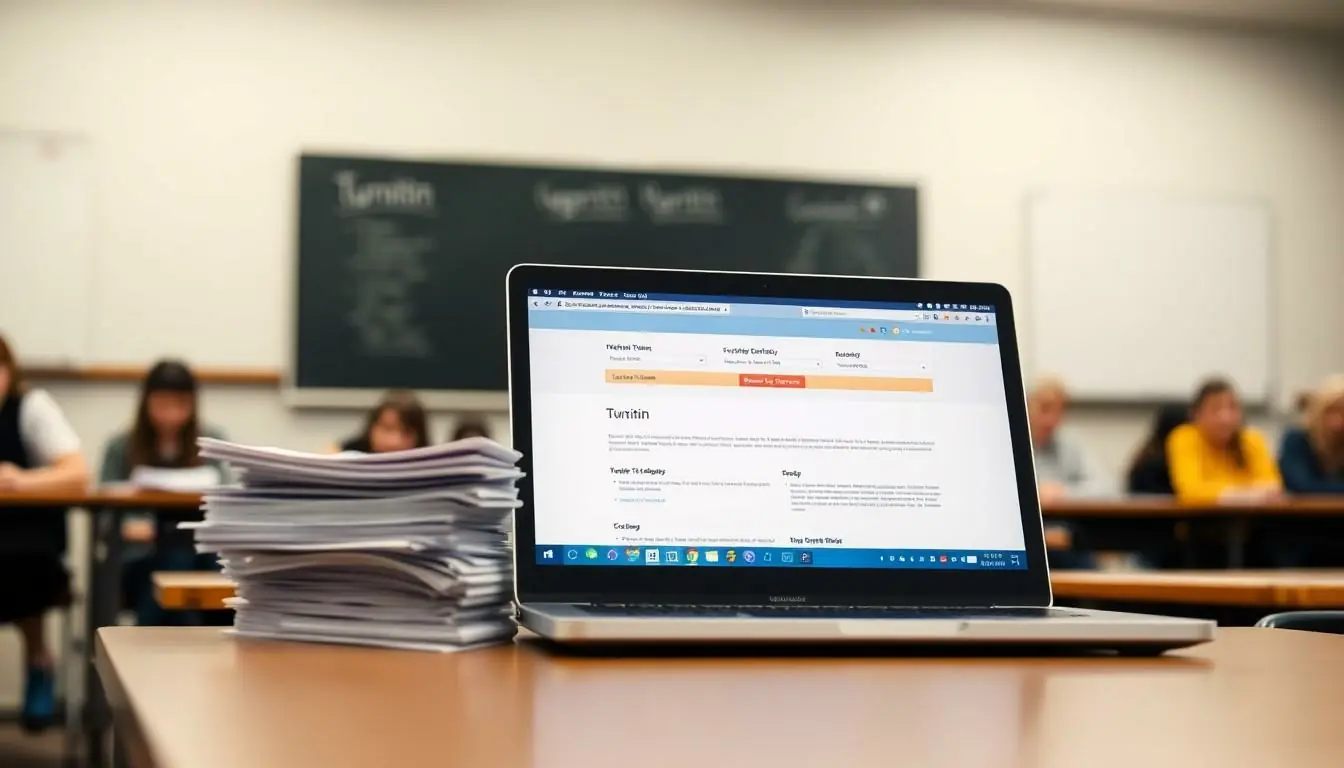As students and educators navigate the digital landscape, a new question arises: can Turnitin catch ChatGPT? With AI writing tools becoming more popular, the stakes for originality have never been higher. Imagine submitting a paper only to find out it’s been flagged for plagiarism—not the plot twist anyone wants!
While ChatGPT can generate impressive content, it’s not immune to scrutiny. Turnitin’s algorithms are designed to detect similarities in text, and that’s where the fun begins. Can AI-generated content slip through the cracks, or does it leave a digital footprint as obvious as a cat on a keyboard? Dive into the intriguing world of AI and academic integrity, where the lines between creativity and compliance blur.
Table of Contents
ToggleUnderstanding ChatGPT and Its Capabilities
ChatGPT functions as an advanced language model created by OpenAI. This model generates human-like text based on given prompts. Various applications utilize its capabilities, including content creation, language translation, and conversational agents.
AI systems, including ChatGPT, rely on vast datasets to learn language patterns. They produce responses by predicting the next word in a sentence. The training applies machine learning techniques to understand context, grammar, and style.
Creative writing and technical explanations exemplify ChatGPT’s versatility. Its ability to adapt to different tones and styles makes it useful for many users. By understanding user intent, this model can craft engaging narratives or informative passages.
Despite its capabilities, challenges exist in distinguishing AI-generated text from human writing. Originality concerns arise as increasingly sophisticated algorithms complicate detection. Detecting similarities in content remains a primary focus of tools like Turnitin when assessing submissions.
Turnitin examines submitted work for potential plagiarism through text matching. The platform compares documents against a database of academic work and web content. Adjustments in ChatGPT’s output could decrease the likelihood of detection but may not guarantee evasion.
Understanding the balance between creativity and academic integrity is essential. The rise of AI technologies like ChatGPT prompts ongoing discussions about originality in writing. Educators and institutions face the task of adapting their approaches in this shifting landscape.
The Functionality of Turnitin

Turnitin plays a crucial role in maintaining academic integrity by detecting potential plagiarism in written submissions. It employs advanced algorithms and databases to analyze text and identify similarities.
How Turnitin Works
Turnitin compares submitted content against a vast repository of academic papers, publications, and web pages. This comparison involves algorithms that identify matching phrases or ideas. Submissions undergo a thorough examination to determine originality. The system generates similarity reports that highlight the matched portions and provide links to the original sources. Educators utilize these reports to assess the likelihood of plagiarism in students’ work effectively.
What Turnitin Detects
Turnitin detects not only direct quotes but also paraphrased content and structural similarities. By analyzing language patterns and contextual references, it identifies instances of potential plagiarism. This capability extends to both human-created and AI-generated text. Users often receive feedback indicating areas of concern, which facilitates a better understanding of academic writing standards. Institutions rely on these insights to uphold integrity and encourage originality in educational environments.
ChatGPT and Academic Integrity
Concerns surrounding academic integrity intensify with the rise of AI technologies like ChatGPT. Institutions face challenges in maintaining originality in student submissions.
The Role of AI in Education
AI enhances educational experiences in various ways. It provides tools for personalized learning, aiding students in grasping complex concepts. Educators leverage AI to streamline grading processes and tailor assignments based on student needs. Increased efficiency allows teachers to focus on facilitating discussions and mentorship. While AI can automate certain tasks, the human touch in education remains invaluable. Integrating AI within curricula sparks conversations on ethics, encouraging students to consider the implications of these technologies.
Originality vs. AI-Generated Content
Determining originality becomes more complex with AI-generated text. Educators stress the importance of original thought and expression, emphasizing the need for critical analysis. Plagiarism concerns arise as AI tools create content that may closely resemble existing work. Originality demands unique perspectives and creativity, which AI often lacks. Institutions encourage students to view AI as a complement rather than a substitute for their writing skills. Finding a balance between utilizing AI for support and fostering personal expression highlights ongoing discussions in academic settings.
Examining the Detection of ChatGPT by Turnitin
Turnitin continues to grapple with the challenge of recognizing AI-generated content, including that produced by ChatGPT. Advanced algorithms focus on pattern recognition while evaluating text similarity to maintain academic integrity.
Evidence and Studies
Research suggests Turnitin can detect AI-generated text, although effectiveness varies. Studies indicate traditional plagiarism detection strategies struggle with nuanced AI language output. ChatGPT’s text may resemble human writing closely, making detection difficult. Evidence shows cases where AI text passes initial scrutiny, yet future algorithm updates may enhance detection capabilities. Papers that incorporate AI text can raise alerts as institutions adapt their methods to address evolving technologies. Understanding these dynamics aids educators in addressing academic integrity issues more effectively.
User Experiences
Users express mixed feelings about Turnitin’s ability to catch AI-generated submissions. Some report that outputs from ChatGPT sometimes slip under the radar, receiving minimal similarity scores. Feedback from students highlights frustration with systems failing to catch subtle AI nuances. Others note that when combined with human input, AI-generated text often raises flags. User experiences emphasize the importance of continued vigilance in maintaining originality standards. Institutions face pressure to update and refine detection methods as AI technology advances.
Best Practices for Using AI Responsibly in Academia
Using AI responsibly in academia involves adhering to a few key practices that promote integrity. Prioritize originality in all submissions. Engaging with AI tools should enhance one’s understanding of the material rather than replace critical thinking. Students can benefit from using AI-generated insights while ensuring their unique perspectives shine through.
Establish guidelines for AI tool usage. Institutions can implement clear policies outlining acceptable uses of AI in academic work. By educating students about these guidelines, expectations around academic integrity become clearer.
Encourage collaboration between AI tools and personal expression. Students might leverage ChatGPT for brainstorming or drafting ideas while refining their final submissions. Emphasizing this collaborative approach cultivates a deeper understanding of the subject matter.
Promote transparency in AI usage. If a student incorporates AI-generated content, disclosing this use can foster honesty and trust. Educators can appreciate the nuances of the student’s work while remaining vigilant about potential integrity issues.
Nurture a culture of ethical AI use. Institutions can hold workshops informing students about the boundaries of AI in their work. As the landscape of academic resources evolves, keeping students informed ensures they navigate AI tools responsibly.
Foster discussions about AI’s impact on creativity and originality in writing. By engaging students in conversations around these topics, educators raise awareness regarding potential pitfalls associated with AI use. Open dialogue contributes to a more informed student body that recognizes the importance of maintaining academic standards.
The intersection of AI technology and academic integrity presents both challenges and opportunities. While Turnitin has made strides in detecting AI-generated content like that from ChatGPT, the effectiveness of its algorithms remains inconsistent. As educational institutions adapt to these advancements, fostering a culture of originality and critical thinking becomes essential.
By encouraging responsible AI use and establishing clear guidelines, educators can help students leverage these tools to enhance their writing rather than replace their own creativity. The ongoing dialogue about AI’s role in academia will shape the future of writing and assessment, ensuring that academic standards are upheld in an increasingly digital landscape.





